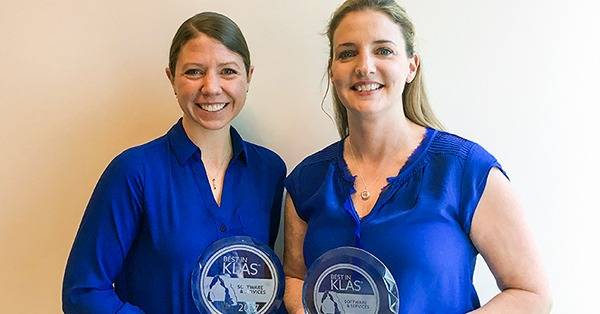- Solutions
- Solutions
- Home Health
- Hospice
- Life Plan Community
- Palliative Care
- Private Duty
- Senior Living
- Skilled Nursing
- Skilled Nursing
- Skilled Nursing Software
- Advanced Insights
- Customer relationship management
- Data and analytics
- Financial & operations management
- Marketing
- Nutrition management
- Referral management
- Regulatory compliance
- Retail management
- Resident engagement
- Revenue cycle management
- Skilled nursing interoperability
- Partners
- Blogs
- Resources
- About

4 reasons to embrace telehealth in your SNF
Telehealth was gaining traction in post-acute facilities before the COVID-19 pandemic. But since March, the landscape has shifted dramatically, and now virtual care has become more than just a convenience: it’s a necessary tool for providing care in skilled nursing facilities.
Bringing a standardized telehealth solution into your facility can be a significant change for attending physicians, nurses, residents, and other staff. But there are compelling reasons from several of these perspectives to consider adding telehealth to your broader virtual care strategy.
Reason 1: CMS
First, telehealth is now mandated. CMS requires a standardized, secure telehealth solution to be phased in, which will support a legal audit trail and progress notes for each encounter. CMS will be auditing these encounters, and if a physician conducts a Zoom call and it’s not in the chart, that’s going to be a problem as this time won’t be reimbursed.
CMS is highly focused on telehealth which is evident in the actions they’re taking. They increased reimbursement for telehealth, so the policy now covers more than 30% of all Medicare recipients. They loosened the rules around originating sites and added many services around telehealth. Additional waivers are going to occur. So, telehealth, from a government perspective, is here to stay.
Reason 2: Attending physicians
We’ve heard that attending physicians may not see the need for a telehealth solution. But telehealth offers them several benefits.
First, it helps them with work/life balance by giving them the option to take calls only during certain hours, with the off-hours support to manage changes in condition, not care plans. Also, these virtual telehealth encounters can be standardized and automatically integrated with the patient’s EHR, which eliminates the need to chase details or re-enter data from one system to another.
Reason 3: Nurses
For nurses in a facility, telehealth can save time, which contributes to the ROI of investing in a system. Nurses no longer have to coordinate a call with the physician or spend time logging and tracking the bill for an encounter. There is no delay between seeing a patient and connecting with a physician, which means the nurse remains focused on the resident the entire time, enhancing care.
Also, because telehealth visits count as qualified visits, CMS will reimburse for each one, which means that every time a nurse helps a patient connect to a provider using a tablet or computer, it offsets the flat monthly fee telehealth SaaS solutions generally charge.
Reason 4: Residents and families
Looking at this from the perspective of residents and their families, it’s not hard to see how much they would want telehealth. If a resident has a change in condition and needs immediate attention from a physician, of course, that should be possible. Any resident or family member would expect that.
Third Eye Health
MatrixCare partners with Third Eye Health to provide telehealth solutions. Third Eye’s physicians are available 24/7 to manage changes in condition such as low blood sugar or a fall with a possible head injury. Third Eye physicians provide support for acute episodes that, if left untreated, can lead to rehospitalizations and poor outcomes.
But in addition to the convenience for attending physicians and peace of mind for residents and families, Third Eye Health offers quantifiable benefits to SNFs, including reduced return-to-hospital rates, access to physicians specializing in post-acute care, and care coordination at end of shift between Third Eye staff and the facility’s care team, to ensure smooth transitions of care.
Conclusion
It’s important to note that telehealth use by adults, ages 50 to 80, is becoming more accepted and used. During the first three months of the pandemic, 25% of older adults had a virtual visit, and 64% of those adults said they were “very” or “somewhat” comfortable with the technology. As adults become more familiar with telehealth technology, concerns about privacy are declining. This means, the use of telehealth is likely to grow.
When considering adding telehealth services to your facility, it’s important to look at many angles. For now, there is good support from CMS and other government bodies, and compelling reasons for government, physicians, nurses, and families to embrace solutions like Third Eye Health.
“Telehealth.” CMS, 24 Apr. 2020, www.cms.gov/Medicare/Medicare-General-Information/Telehealth.
Request a demo today for a closer look at MatrixCare.
See what MatrixCare can do for you
Frank Nash
Focused solely on Healthcare Information Systems for 20 years, Frank's teams have successfully built and delivered interoperability, clinical and financial web-based workflow applications in all aspects of the healthcare market. From Acute/LTAC to LTPAC, all delivered as SaaS solutions, to all types of users, from healthcare professionals to patients and families. Currently, Frank leads the CareCommunity platform team and telehealth solutions team at MatrixCare. CareCommunity is designed to connect all caregivers, as well as patients and their families, focusing on transitions of care, care coordination, and resident engagement. Prior to MatrixCare, Frank worked for Healtheon, the first healthcare company to build internet-based solutions for healthcare, and helped lead a startup, building interoperability, and other web-based workflow solutions, which lead to a successful exit to NTTData, a division of NTT.
Related Posts


See MatrixCare in action
Start by having a call with one of our experts to see our platform in action.
MatrixCare offers industry-leading software solutions. Thousands of facility-based and home-based care organizations trust us to help them improve efficiency and provide exceptional care.
© 2024 MatrixCare is a registered trademark of MatrixCare. All rights reserved.






